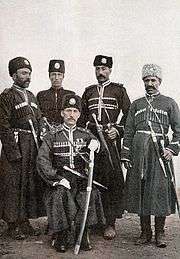Qarapapaqs
The Qarapapaqs or Karapapaks (Azerbaijani: Qarapapaqlar, Tərəkəmələr; Turkish: Karapapaklar) are a Turkoman[3] sub-ethnic group of Azerbaijanis who mainly live in Azerbaijan, Iran, Georgia, and in the northeast of Turkey near the border with Georgia and Armenia, primarily in the provinces of Ardahan (around Lake Çıldır), Kars and Ağri.[4][5][6][7][8][9] The exact number for the Qarapapaq population worldwide is unknown but is likely to be in the hundred thousands.[1]
Qarapapaqlar, Tərəkəmələr | |
|---|---|
 Group of Qarapapaq Hamidiyeh Cavalry, Ottoman Empire (1901) | |
| Total population | |
| Unknown (estimated to be in the hundred thousands)[1]
•Azerbaijan ~1,000,000- 2,000,000 •Turkey ~5,000,000- 7,000,000 •Georgia ~500,000 •Russia ~700,000 | |
| Regions with significant populations | |
| Iran, Turkey, Georgia, Russia, Kazakhstan, Azerbaijan (Mostly western part and big cities such as Baku, Sumgait, Lankaran, Shirvan), Ukraine, Canada, United States of America, Armenia (USSR period), Uzbekistan, Germany, Belarus | |
| Languages | |
| Azerbaijani | |
| Religion | |
| Mostly Sunni Islam[2] Minority Shia Islam | |
| Related ethnic groups | |
| Azerbaijanis |
Origins and history
Sometimes referred to as Terekeme or Tarakama (from Arabic: "تراكمة" (Tarākameh), the Arabic broken plural for Turkmen—a term traditionally used for any Turkic nomadic people, Qarapapaqs are often identified as a sub-ethnic group of Azerbaijanis,[10] even though in the Brockhaus and Efron Encyclopedic Dictionary they are sometimes listed as a separate ethnic group.[11] Theories of Qarapapaqs descending from Kumyks (a Turkic ethnic group in Dagestan) have also been brought forward by scholars like Fahrettin Kırzıoğlu and Zeki Velidi Togan.[12] The Terekeme originally populated territories in what is now southern Georgia, northwestern Armenia, southern Dagestan, and central and northwestern Azerbaijan,[13] but almost entirely migrated to Persia and the Ottoman Empire upon Russia's conquest of Persia's territories in the North Caucasus and South Caucasus between 1813 and 1828 during the Russo-Persian War (1804-1813) and the Russo-Persian War (1826-1828). Here they were given the name Karapapakh ("black hat") by the Anatolians reflecting the element of the Terekeme ethnic outfit that distinguished them from the local population.[12]
Russia's expansion to Kars (in Eastern Turkey) in 1878 as a result of the Russo-Turkish War led to some Qarapapaq settlements becoming part of Russia once again. With the Russian Revolution and Soviet expansion south in late 1910s and 1920s, Qarapapaqs became a new nationality group in Soviet Union. Late in 1930s, the Soviet Union stopped classifying Qarapapaqs as a separate people and in 1944, they were included in the mass deportation of Meskhetian Turks from Georgia to Central Asia.[14]
Even though the Qarapapaqs left in the Caucasus had largely assumed Azeri identity[1] by the mid-20th century and despite lack of record of Qarapapaqs in modern censuses of the South Caucasus states, nowadays small groups may still identify themselves as Qarapapaq or Terekeme in the regions originally inhabited by them. Qarapapaqs are also found in Central Asia where many of them were deported along with the Meskhetian Turks in 1944 during the Stalinist population transfers.[1] The last census to mention Qarapapaqs as a separate ethnic group was the 1926 Soviet census, according to which there were 6,311 of them throughout the South Caucasus.[15]
Language
Qarapapaqs speak a dialect of Azerbaijani.
Religion
Most Qarapapaqs are Sunni Muslims. But some of them are Shia of the Twelvers school of thought.[2] In the Brockhaus and Efron Encyclopedic Dictionary, those identifying with the Caferi strand are listed as Turkmen (Tarakama).[16]
Culture
Qarapapaqs have developed rich traditions of oral literature consisting largely of ashik songs, legends and folk tales.
See also
References
- (in Turkish) The Great Borchali and the Karapapak Archived 1 June 2007 at the Wayback Machine by Seyfullah Türksoy
- Alexandre Bennigsen & Enders Wimbush. (1986). Muslims of the Soviet Empire
- Article "Terekimes»:«The term “Terekem” is usually associated with the ethnonym “Turkmen”.
- "Azerbaijani People in Ağrı".
- "Azeri in Ağrı".
- "Karapapak in Ağrı".
- "Ağri-karapapak".
- "Ağrı'da 'Şah Bezeme' Geleneği Yüz Yıllardır Devam Ediyor". m.haberler.com (in Turkish). Retrieved 19 April 2018.
- https://www.sondakika.com/. "Ağrı'da 'Şah Bezeme' Geleneği Yüz Yıllardır Devam Ediyor". m.sondakika.com. Retrieved 19 April 2018.
- (in Russian) Azeris. Great Soviet Encyclopedia
- (in Russian) Kavkazski Krai. Brockhaus and Efron Encyclopedic Dictionary
- (in Russian) Kumyk Communities Abroad by Kamil Aliyev
- (in Turkish) Karapapaklar Archived 27 September 2007 at the Wayback Machine. Karapapak.com
- Ronald Wixman.(1984).The Peoples of the USSR: An Ethnographic Handbook.
- (in Russian) The All-Soviet of 1926: the Transcaucasian SFSR
- (in Russian) Kars Oblast. Brockhaus and Efron Encyclopedic Dictionary